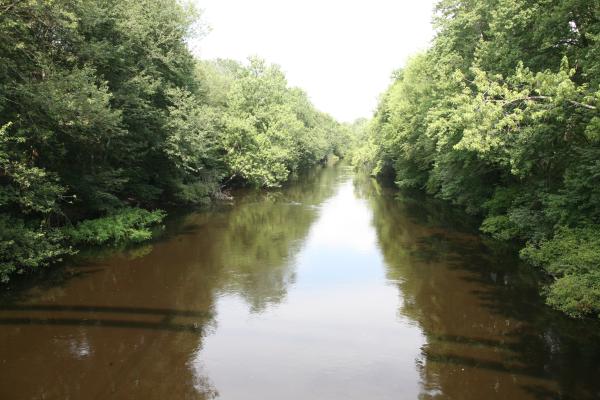August 9, 2023

The Neponset River looking west from the Harvey Bridge near Ryan Playground. Seth Daniel photo.
Sections of the three major rivers flowing into Boston Harbor received poor grades, including Ds and failing marks, according to new report cards for 2022 that cite impacts from millions of gallons of dirty sewage and stormwater releases.
While there’s been “vast overall improvements” for the Charles, Mystic, and Neponset rivers compared to past decades, the impacts of climate change could hinder that progress. Disparities in water access and quality were also evident in communities of color where residents are low-income and language isolated, according to the report from the US Environment Protection Agency (EPA), Charles River Watershed Association, Mystic Watershed Association, and Neponset River Watershed Association.
“Today’s report card of water quality in the major urban rivers of Boston and surrounding communities underscores that when communities, governments at all levels, and organizations come together, we can solve long-standing environmental and equity challenges to create healthier rivers,” EPA New England Regional Administrator David Cash said in a statement.
“But the report also highlights rivers that are polluted, especially in underserved and overburdened communities that deserve to enjoy a clean and healthy environment. More work is needed to bring environmental justice to these communities.”
Rivers and other bodies of water in Massachusetts have long struggled with deteriorating conditions associated with heavy rains, which can overwhelm public systems that handle sewage and also send polluted stormwater runoff into open waters.
Green infrastructure projects – such as rain gardens, permeable pavements and tree trenches – are urgently needed to halt pollution in rivers and flooding in homes, as well as to boost the climate resiliency of neighborhoods, the report indicates.
“The impact of climate change on the rivers is no longer a future threat, it’s here now,” Fred Laskey, executive director of the Massachusetts Water Resources Authority, said in a statement. “We must continue to work together to find viable and affordable solutions.”
In the report cards, rivers were graded based on the percentage of time that E. coli bacteria concentrations are safe for recreation and precipitation data. For the Charles River, the recreation health score incorporates two additional threats, combined sewer overflow (CSO) discharges and the presence of cyanobacteria blooms, which can harm people, animals, or the environment by taking oxygen and nutrients away from other organisms, according to the Centers for Disease Control and Prevention.
There were 53 known CSO events in the Charles in the summer of 2021 amid 35 inches of precipitation, causing more than 126 million gallons of sewage and stormwater to be discharged into the river, according to the report. In 2022, some sections of the Charles were “nearly dry,” including in Bellingham, Medfield, Needham, Newton, and Waltham where observed water levels fell below half a foot, according to the report.
While parts of the Charles River’s upper and middle watershed got A marks, the Muddy River received a C, marking a slight improvement from a prior C- grade, the report card shows.
“However, a C grade is still not acceptable, and the Muddy remains the most polluted above-ground tributary within the Charles River watershed,” the report stated.
The mainstem of the Mystic River watershed boasts “generally good water quality,” though parts of the mainstem and streams had “marginal declines” in their report card grades. Tributaries had poor grades due to sewage contamination. The Alewife Brook and Malden River received D grades, for example, while Mill Creek got an F, the report card shows.
CSO releases are a “commonplace occurrence” for the Mystic River, and the overflows were exacerbated by 14 inches of rain recorded in July 2021, said Patrick Herron, executive director at the Mystic River Watershed Association.
“Reports show CSOs are more likely to occur near environmental justice communities, like Alewife Brook,” Herron said in a statement. “We understand that the elimination of remaining CSOs will be expensive, but we believe investment in public health and safety for all communities is worth it, given these discharges inhibit residents from fully enjoying vital greenspaces and riverways.”
The Neponset River similarly saw A and B grades for in its mainstem, and ponds and lakes received high marks for swimmability. Yet water quality worsened in “many” tributaries in 2022, particularly in municipalities with the largest populations and impervious surface areas.
The Unquity and Germany brooks received D- grades, while the Meadow Brook got an F, the report card shows. The report states the Neponset River’s declining health is likely due to extreme weather, including drought and increased precipitation, over the last three years.
Stormwater pollution poses “one of the greatest threats to clean water,” the report stated.
With more than 80 percent impervious cover for some communities along the watersheds of the Charles, Mystic, and Neponset rivers, heavier rainful leads to gasoline, trash oil, pet waste and “more” flowing into storm drains from roads, parking lots and roofs, according to the report. That can translate into “rampant invasive species growth, toxic cyanobacteria blooms, and even fish kills,” the report stated.
The prolonged drought in 2022 “significantly affected” Massachusetts rivers, the report stated, as droughts can result in higher concentrations of bacterial pollution and “devastating consequences for the river ecosystem, wildlife, and all who depend on healthy rivers for drinking water, recreation, and enjoyment.”


